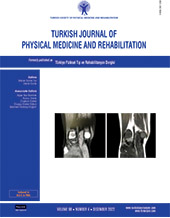The effect of whole-body vibration on spasticity in post-stroke hemiplegia: A prospective, randomized-controlled study
2 Istanbul Gelişim University, Faculty of Dentistry, Istanbul, Türkiye DOI : 10.5606/tftrd.2022.10391 Objectives: This study aims to investigate whether whole-body vibration (WBV) has an anti-spastic effect on the ankle plantar flexors.
Patients and methods: This single-blind, prospective, randomized-controlled clinical study included a total of 48 patients with chronic stroke (33 males, 15 females; mean age: 60.7±10.9 years; range, 25 to 80 years) between May 2019 and February 2020. They were randomized into two groups: WBV group (n=24) and sham WBV group (n=24). A training program of 12 sessions (three days a week for four weeks) was applied regularly in both groups. The spasticity degree of the plantar flexors was evaluated by using both a subjective assessment method (modified Ashworth scale [MAS]) and several objective assessment methods (Hmax/Mmax, homosynaptic post-activation depression [HPAD], and torque) before and after the training program.
Results: There were no significant changes in the torque values, Hmax/Mmax, and HPAD level after the training program in both groups (p>0.05). However, the MAS score in the WBV group significantly decreased (-9.0%), but no change in the control group was observed (0.7%) (p=0.027, effect size = 0.32).
Conclusion: The objective assessment methods for spasticity show that WBV has no anti-spastic effect.
Keywords : Hemiplegia, rehabilitation, spasticity, stroke, whole-body vibration

















